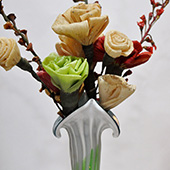Design Resource
Corn Husk and Dry Chilli Flowers - Ahmednagar, Maharashtra
Best out of waste
by
Prof. Bibhudutta Baraland Srikanth B.
Artificial flowers are imitations of natural flowering plants. They come in two forms, one which is made out of natural materials like linen, corn husk, ductile metals, silkworm cocoons, rice paper, feathers, wax, shells, etc. and the other of man-made substances like polymer fabric, plastics, and nylon nets. These decorative flowers that have lit our residential and office spaces, have a history of 1,500 years. Evolving, now the craft has gained more realistic textures and appearances. Ancient Egypt had a tradition of creating floral wreaths from corn husks, thin plates of copper, gilt that were silvered or stained in various shades. Romans also practiced wax flower making, which was regarded for their detailing and realistic look. The technique is unseen in today’s age. While the artificial flower works of Italy were the first to be celebrated worldwide for their execution and style, they stood out immensely from others, and France and we followed the trend with slight modification in the coming ages. The early form of artificial flowers was mostly made out of multi-colored ribbons that were twisted and warped around small pieces of wire.
Some of the types of artificial flowers available in the market are as follows:
Fabric-Based Flower: Here silk fabrics are shaped into the forms of roses, lilies, peonies, flora, blossoms, gerberas, orchids, and more. This is the most common type in a huge variety of choices available in the market, where each petal in the flower is always made slightly different from others to recreate the same as in nature.
Foam Flowers: It is the cheapest variety that is regarded for its lightweight, ease of creation, and lifelike looks when mixed in a bouquet. These are manufactured by fixing a number of thin foam petals to a polystyrene ball. They are extremely durable and flexible to bend into divergent angles.
Wax Coated Flowers: These are silk fabric flowers coated in oily wax. It gives a much genuine feel of a real flower than an uncoated silk flower. The layer of coating is mainly done to establish more realism.
Latex Flowers: These are similar to the wax-coated flowers, but the only difference is that here latex is used as a base layer than a silk fabric, thus making the petals more thick and rigid. The end products usually resemble tropical flowers like orchids, plumeria, anthurium, etc. They are also coated in a thin layer of wax giving lifelike patterns.
Fresh Touch Flowers: Fresh touch flowers are made by combining foam petals and latex, making them softer than other varieties. They are popularly called ‘fresh touch’ flowers.
Preserved Flowers: When freshly plucked flowers are placed into a Glycerin compound and its parts get soaked in the mixture, it makes preserved flowers. Though they are externally beautiful and unchanging in appearance, they are too delicate to be worked upon for floristry works.
The Theme of the Cornhusk and Dry Chilli Flower Making:
Cornhusk flowers are quite handy decoration material hence widely used in winter weddings, floral displays, craftworks, and other beautifying works. Handicraft artisans who specialize in artificial flower making and its trading are enormous in our country. Mrs. Varsha Shekatkar is the one among them who is a founding member of Rachana Kala Mahavidyalaya institute, an Ahmednagar-based art and craft center. The center which was started in the year 1998, is now a handicraft hub producing corn husk and dry chilli flowers, socks dolls, thread jewelry, and many more while being an income source for many women residing nearby.







